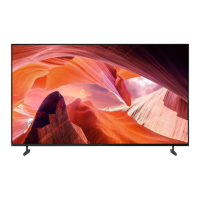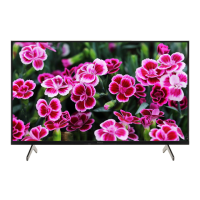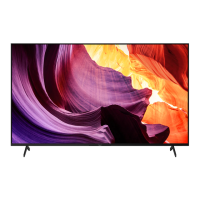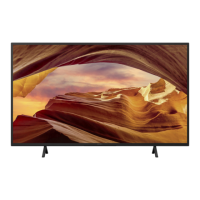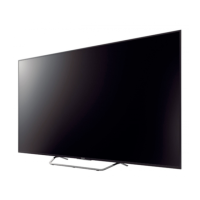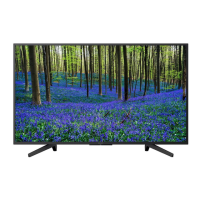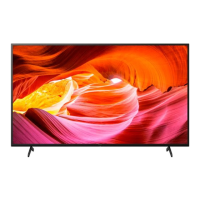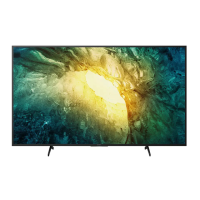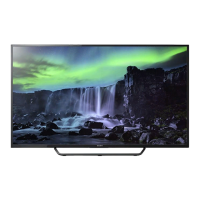Do you have a question about the Sony KD-43XE7 Series and is the answer not in the manual?
General safety warnings and precautions for service personnel handling electronics.
Critical guidelines for safe handling and preventing damage to the LCD panel during service.
Safety precautions for handling, replacing, and disposing of lithium batteries.
Essential safety verification steps before releasing the unit to the customer.
Procedure for measuring leakage current to ensure user safety from electric shock.
Guidance on identifying and verifying effective earth ground connections for safety.
Details concerning the use of lead-free solder on circuit boards and its implications.
Best practices and warnings for the correct insertion and removal of FFC connectors.
Explanation of the standby LED states and their meanings during various TV operations.
Table mapping LED blinking patterns to specific error detections and their locations.
A flowchart correlating symptoms with potential faulty boards based on LED diagnostic sequences.
Diagnostic procedure for main power errors indicated by a 2x LED blinking pattern.
Diagnostic procedure for audio system errors indicated by a 3x LED blinking pattern.
Diagnostic procedure for panel power errors indicated by a 4x LED blinking pattern.
Diagnostic procedure for panel I2C communication errors indicated by a 5x LED blinking pattern.
Troubleshooting steps for scenarios where the backlight is visible but no image is displayed.
Troubleshooting guide for no picture faults related to Analog, Digital, and Satellite tuner reception.
General checking procedure for resolving no picture issues when using HDMI inputs.
Steps to troubleshoot Wi-Fi connectivity problems, including device searching and connection failures.
Diagnostic steps for troubleshooting no picture faults within the analog video signal path.
A structured approach to diagnosing and resolving various audio output problems.
Troubleshooting guide for power-related faults involving DDCON and LDO voltage regulators.
Step-by-step instructions on how to navigate into the TV's hidden service menu.
Information on service mode features and their regional availability based on TV model.
Summary of remote control key operations for navigating and interacting within the service menu.
Procedure to access the self-diagnosis function for checking system status and errors.
Guide to interpreting error codes, operation times, and LED flash data from the diagnosis menu.
Mapping standby LED flashing counts to specific monitoring items and failure types.
Confirmation process for correct Panel Selection and LVDS Spectrum (%) settings.
Instructions for modifying the TV's serial number through the service menu.
Steps for setting or changing the TV's model number, typically done once.
Detailed steps for adjusting white balance parameters like R/G/B Gain and Offset.
Procedure for transferring Picture Quality (PQ) related data after component replacement.
Instructions on entering aging mode and performing a test reset sequence.
Process for checking tuner status, expected type, and region compatibility.
How to disable ATMOS CEC to prevent conflicts with connected audio devices.
Setting CEC Force LA to '0' or 'A' to manage CEC communication and prevent conflicts.
Method for retrieving HDMI EDID information directly from the TV's service menu.
Adjusting option bits for shipping region and tuner type, critical for correct TV operation.
Visual diagrams showing the location of major circuit boards within the TV.
A functional block diagram illustrating the main components and data flow of the TV system.
Detailed diagrams showing pin assignments for various connectors on the main boards.
General safety warnings and precautions for service personnel handling electronics.
Critical guidelines for safe handling and preventing damage to the LCD panel during service.
Safety precautions for handling, replacing, and disposing of lithium batteries.
Essential safety verification steps before releasing the unit to the customer.
Procedure for measuring leakage current to ensure user safety from electric shock.
Guidance on identifying and verifying effective earth ground connections for safety.
Details concerning the use of lead-free solder on circuit boards and its implications.
Best practices and warnings for the correct insertion and removal of FFC connectors.
Explanation of the standby LED states and their meanings during various TV operations.
Table mapping LED blinking patterns to specific error detections and their locations.
A flowchart correlating symptoms with potential faulty boards based on LED diagnostic sequences.
Diagnostic procedure for main power errors indicated by a 2x LED blinking pattern.
Diagnostic procedure for audio system errors indicated by a 3x LED blinking pattern.
Diagnostic procedure for panel power errors indicated by a 4x LED blinking pattern.
Diagnostic procedure for panel I2C communication errors indicated by a 5x LED blinking pattern.
Troubleshooting steps for scenarios where the backlight is visible but no image is displayed.
Troubleshooting guide for no picture faults related to Analog, Digital, and Satellite tuner reception.
General checking procedure for resolving no picture issues when using HDMI inputs.
Steps to troubleshoot Wi-Fi connectivity problems, including device searching and connection failures.
Diagnostic steps for troubleshooting no picture faults within the analog video signal path.
A structured approach to diagnosing and resolving various audio output problems.
Troubleshooting guide for power-related faults involving DDCON and LDO voltage regulators.
Step-by-step instructions on how to navigate into the TV's hidden service menu.
Information on service mode features and their regional availability based on TV model.
Summary of remote control key operations for navigating and interacting within the service menu.
Procedure to access the self-diagnosis function for checking system status and errors.
Guide to interpreting error codes, operation times, and LED flash data from the diagnosis menu.
Mapping standby LED flashing counts to specific monitoring items and failure types.
Confirmation process for correct Panel Selection and LVDS Spectrum (%) settings.
Instructions for modifying the TV's serial number through the service menu.
Steps for setting or changing the TV's model number, typically done once.
Detailed steps for adjusting white balance parameters like R/G/B Gain and Offset.
Procedure for transferring Picture Quality (PQ) related data after component replacement.
Instructions on entering aging mode and performing a test reset sequence.
Process for checking tuner status, expected type, and region compatibility.
How to disable ATMOS CEC to prevent conflicts with connected audio devices.
Setting CEC Force LA to '0' or 'A' to manage CEC communication and prevent conflicts.
Method for retrieving HDMI EDID information directly from the TV's service menu.
Adjusting option bits for shipping region and tuner type, critical for correct TV operation.
Visual diagrams showing the location of major circuit boards within the TV.
A functional block diagram illustrating the main components and data flow of the TV system.
Detailed diagrams showing pin assignments for various connectors on the main boards.
| Screen Size | 43 inches |
|---|---|
| Display Type | LCD |
| Smart TV | Yes |
| Operating System | Android TV |
| Wi-Fi | Yes |
| HDMI Ports | 4 |
| USB Ports | 3 |
| Audio Output | 20W |
| Refresh Rate | 50Hz / 60Hz |
| Backlight Type | Edge LED |
| Ethernet | Yes |
| Processor | 4K X-Reality PRO |
| Bluetooth | Yes |
| Resolution | 3840 x 2160 (4K Ultra HD) |
| HDR | HDR10, HLG |
